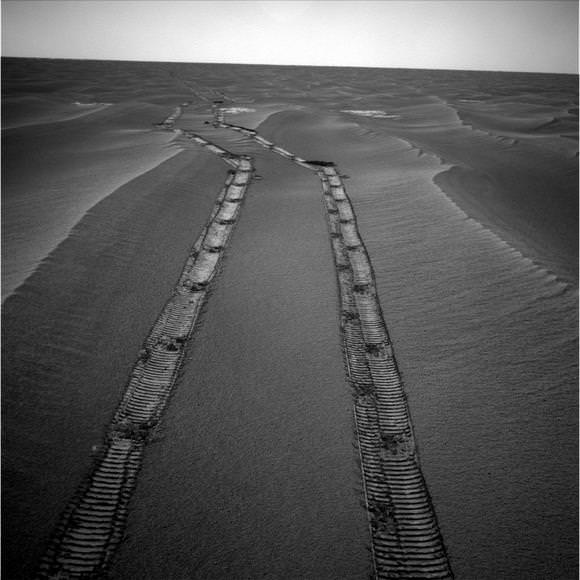[/caption]
Congrats to the science and engineering teams for the Mars Exploration Rover program! Today, (Thursday May 20) the Opportunity rover marked an historic milestone: it has now passed the duration record set by NASA’s Viking 1 Lander of six years and 116 days operating on the surface of Mars. The celebration was tempered just a bit because Oppy may be the longest lasting mission on Mars, or it may be second to its twin, Spirit. Spirit has not communicated with Earth since March 22, succumbing to the cold and decreased power from its solar panels. If Spirit awakens from hibernation and resumes communication, then she will attain the Martian surface longevity record.
The rover teams are encouraged now about resuming communications with Spirit, as the winter solstice has now passed, on May 12 here on Earth. “Passing the solstice means we’re over the hump for the cold, dark, winter season,” said Mars Exploration Project Manager John Callas.
Unless dust interferes, which is unlikely in the coming months, the solar panels on both rovers should gradually generate more electricity. Operators hope that Spirit will recharge its batteries enough to awaken from hibernation, start communicating and resume science tasks.

Opportunity is doing well and still driving towards Endeavour crater, but making shorter drives since there is less power available from the solar panels. But that should continue to improve.
For the next few weeks, some of Opportunity’s drives have been planned to end at an energy-favorable tilt on the northern face of small Martian plain surface ripples. The positioning sacrifices some distance to regain energy sooner for the next drive. Opportunity’s cameras can see a portion of the rim of Endeavour on the horizon, approximately eight miles away, across the plain’s ripples of windblown sand.
“The ripples look like waves on the ocean, like we’re out in the middle of the ocean with land on the horizon, our destination,” said Steve Squyres principal investigator for the two rovers. “Even though we know we might never get there, Endeavour is the goal that drives our exploration.”

Viking was a flagship mission that launched in 1975. It consisted of two orbiters, each carrying a stationary lander. Viking Lander 1 was the first successful mission to the surface of Mars, touching down on July 20, 1976. It operated until Nov. 13, 1982, more than two years longer than its twin lander or either of the Viking orbiters. The record for longest working lifetime by a spacecraft at Mars belongs to a later orbiter: NASA’s Mars Global Surveyor operated for more than 9 years after arriving in 1997. NASA’s Mars Odyssey, in orbit since in 2001, has been working at Mars longer than any other current mission and is on track to take the Mars longevity record late this year.


I’ve gazed in awe at the images sent back from these amazing spacecraft. I hope to look at them in a museum on Mars one day.
I watched a Nat’l Geo special about the rovers again this week. Steve Squires, the proud ‘father’, has spent 16 years on this project. THAT’s a long time! Does that make the rovers teenagers? Uh ohh…. Thanks for the humor Dr.Flimmer! Anthropomorphic angst anyone?
Spirit?
Ah, Spirit:
http://xkcd.com/695/
NASA needs to send a small maintenance craft to Mars to clean up Spirit and Opportunity and future rovers. It could wipe off or vacuum up the dust on their solar panels, maybe do some basic tuneup and help nudge them when they get stuck in a rut. It would have to be something relatively simple and inexpensive and disposable so new ones could be launched every few years.